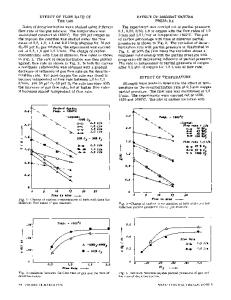Synthesis of Chromium Silicides in Ionic Melts
- PDF / 5,191,981 Bytes
- 13 Pages / 594 x 792 pts Page_size
- 5 Downloads / 336 Views
SYNTHESIS OF CHROMIUM SILICIDES IN IONIC MELTS V. V. Malyshev,1, 2, 3 D. B. Shakhnin,3 A. І. Hab,3 V. S. Kublanovs’kyi,1 and D. Schuster4
UDC 544.653.1: 546+546.281+546.76+621.3.035.45
We study the currentless diffusion saturation, metal-thermal reduction, and the electrochemical behaviors of chromium- and silicon-containing melts and establish the conditions of synthesis of chromium silicides in the form of superfine powders and coatings. It is shown that the role of limiting stage of the process of diffusion saturation of chromium, molybdenum, and tungsten with silicon in chloride-fluoride melts is played by the diffusion of silicon atoms in the solid phase. In the course of currentless transfer of silicon to metals of group VIB, silicide coatings are formed on their surfaces. The combined reduction of chromium (III) chloride and sodium fluorine-silicate by metallic sodium or magnesium makes it possible to obtain silicide powders. We formulate the conditions required for getting powders of chromium silicides by electrolysis of chloride-fluoride melts containing fluorine-silicate and potassium chromate. The oxidation resistance of the obtained silicide powders is explained by the formation of silicon-oxide layers on their surfaces. Keywords: chromium, silicon, silicides, currentless diffusion saturation, metal-thermal reduction, superfine powders, electrochemical synthesis.
Introduction Silicides of metals from groups IV–VIB are promising materials for new branches of engineering connected with the use of high temperatures, velocities, loads, corrosive media, and semiconducting materials. Among the alternative methods of getting nanocrystalline powders of silicides of metals from groups IV–VIB with given stoichiometric compositions, we can mention the following methods, which are used especially extensively: currentless diffusion saturation, metal-thermal reduction of the compounds of metals from groups IV–VIB and silicon with alkaline and alkaline-earth metals, and electrochemical synthesis (ES) from the melts [1–6]. Chromium silicides are widely applied in different branches of the contemporary science and engineering. This is explained by their valuable physicochemical properties and high thermal and chemical stability. It is also worth noting that chromium silicides are environmentally safe materials. They are characterized by high melting temperatures (∼ 1773–2073°K), which explains their extensive application as protective coatings for structural materials and in the production of the components of turbines and aircraft engines operating under the action of corrosive media [6, 7]. Special attention should be given to chromium disilicide ( CrSi 2 ), which is a high-temperature semiconducting material with a narrow band gap (0.35 eV). Its application in microelectronics, in particular, for the development of thermoelectric energy converters, which may operate together with silicon solar elements, seems to be quite promising [8]. 1 2 3 4
Vernadsky Institute of General and Inorganic Chemistry, Ukrainian Nation
Data Loading...









